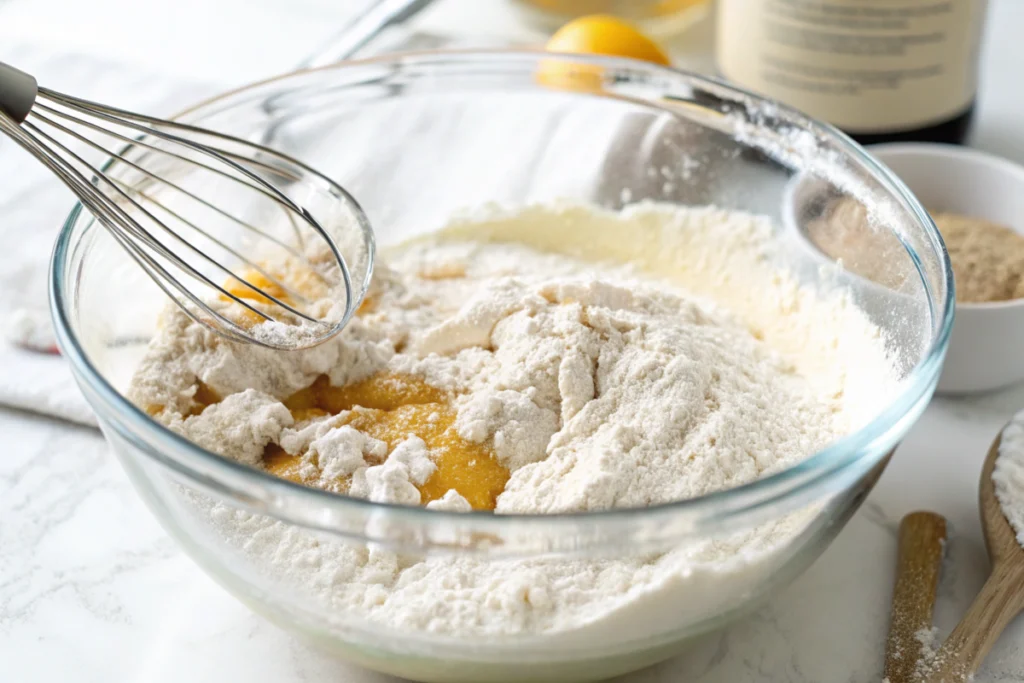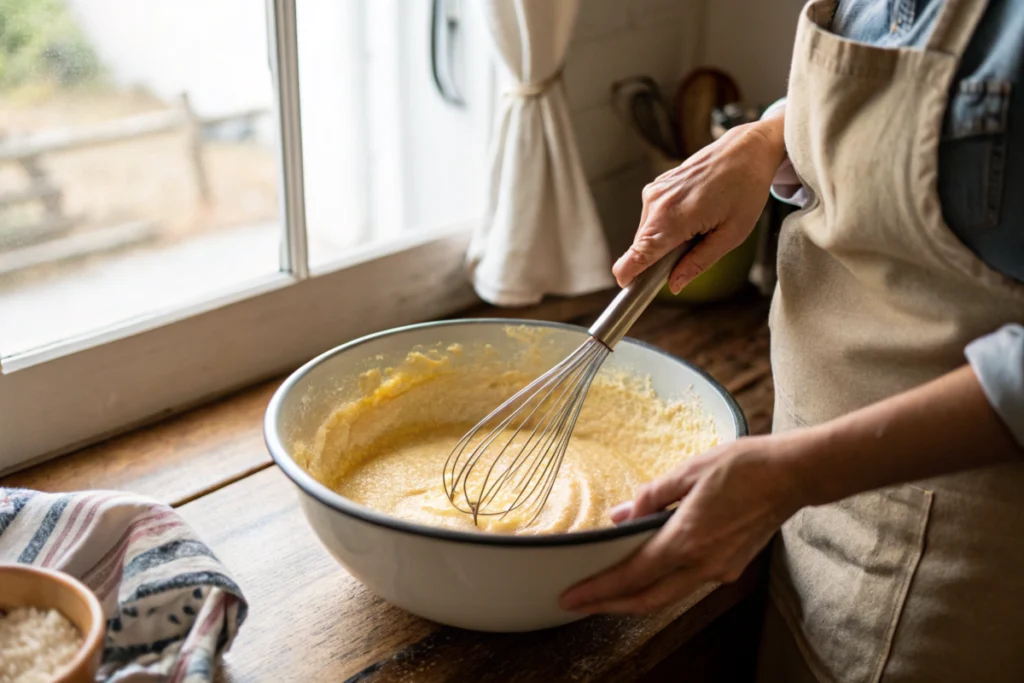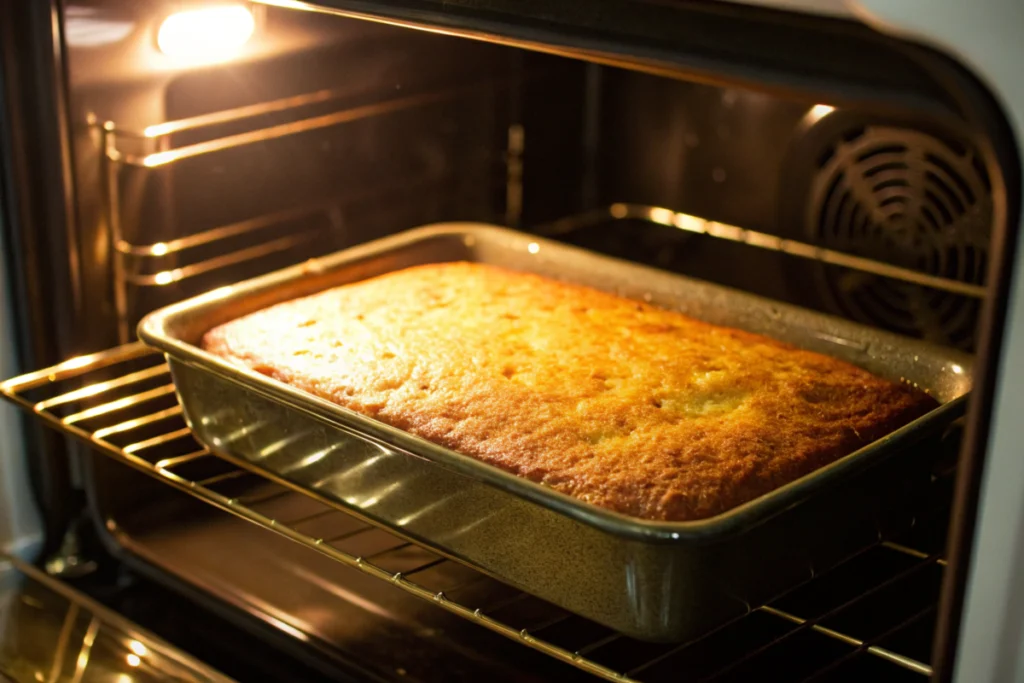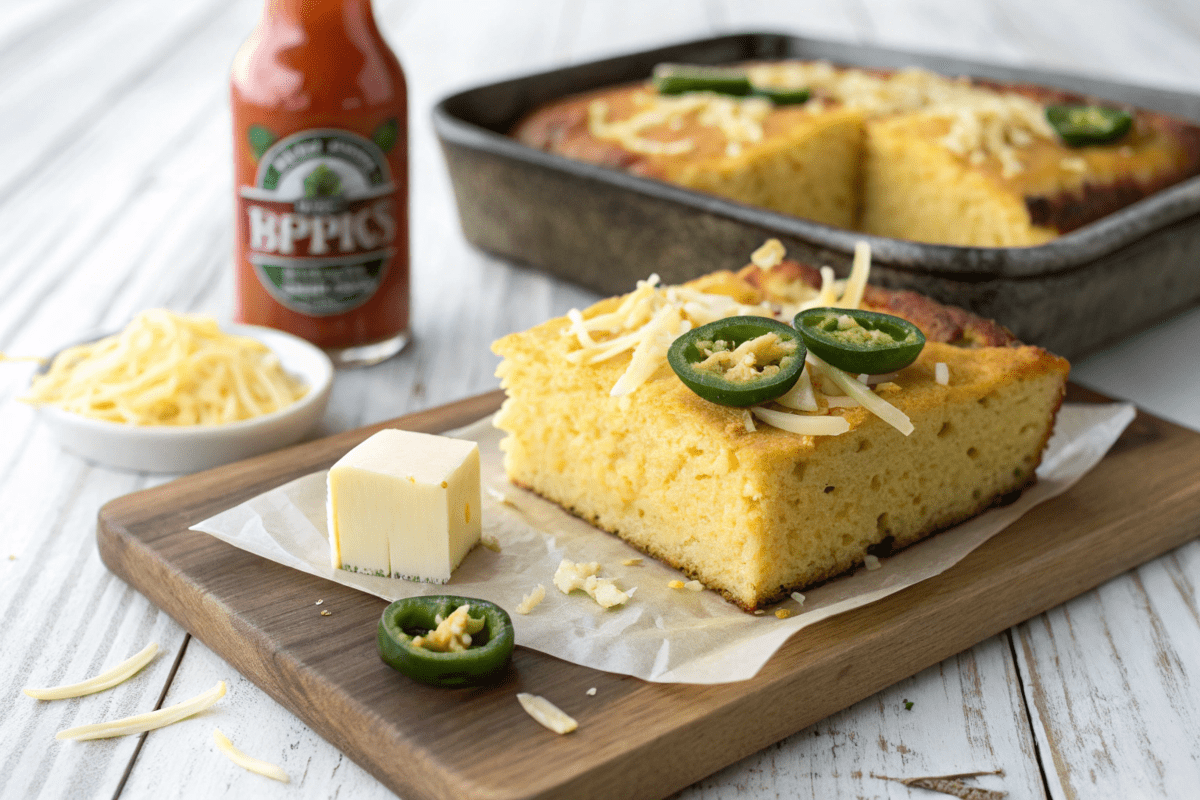Introduction : What Ingredient Keeps Cornbread from Crumbling?
If you’ve ever baked cornbread only to have it crumble apart the moment you cut into it, you’re not alone. “What ingredient keeps cornbread from crumbling?” is a common question among home bakers who crave that perfect balance of moistness and structure. A crumbly cornbread can turn a comforting dish into a frustrating experience; however, with a few tweaks, you can transform your cornbread into a masterpiece.
Cornbread is a beloved staple, deeply rooted in Southern cooking traditions. Its tender, golden texture pairs beautifully with chili, fried chicken, or even a dollop of honey butter. Yet, achieving the ideal texture—one that’s neither too dry nor overly dense—can feel like a culinary puzzle. In fact, the good news is that the solution often lies in just one or two ingredients that act as the perfect binders or moisture enhancers.
Therefore, in this article, we’ll delve into the secrets of cornbread’s consistency. You’ll learn how ingredients like buttermilk, eggs, and even a touch of sugar can work wonders to prevent crumbling. On the other hand, if you’re experimenting with vegan recipes, substitutions like flaxseeds or applesauce can provide similar results.
By the end of this guide, you’ll not only understand what ingredient keeps cornbread from crumbling, but also how to adapt your recipe to suit your preferences and dietary needs. Thus, you’ll always enjoy perfectly moist and cohesive cornbread.

Ingredients: The Secret to Keeping Cornbread from Crumbling
The key to preventing cornbread from falling apart lies in using the right combination of ingredients. In addition, knowing how each part affects the texture is important for getting great results. Let’s go over the key ingredients and what they do.
1. Eggs: The Natural Binder
Eggs are one of the most important ingredients for keeping cornbread together. They act as a natural glue, holding the bread in one piece while also adding moisture. However, if you’re making a vegan version, flax eggs or chia seeds can work just as well.
2. Buttermilk: Adds Moisture and Flavor
Traditional Southern cornbread recipes often call for buttermilk, which not only brings a tangy taste but also makes the bread more moist. The acidity in buttermilk reacts with baking soda, creating a tender texture that’s less likely to fall apart. Thus, it’s an excellent choice for a cohesive loaf.
3. Oil or Butter: Keeps the Bread Soft
Fats like oil or melted butter are key for making cornbread moist. Without enough fat, the bread can become dry and crumbly. For example, vegetable oil is mild and works well, while butter adds a rich flavor.
4. Flour-to-Cornmeal Ratio: Finding the Right Mix
Using too much cornmeal in your recipe can make the texture rough and crumbly. Therefore, a good mix of flour and cornmeal is necessary. Flour gives the bread the strength to hold together, while cornmeal provides the classic flavor and grainy texture.
5. Sweeteners: Optional but Helpful
While sugar or honey isn’t required, adding a little can help keep the bread moist. On the other hand, if you prefer savory cornbread, skipping sweeteners won’t hurt its structure as long as you have other binding ingredients.
6. Optional Add-ins: Boosting Texture and Flavor
Things like sour cream, cream-style corn, or grated cheese can also improve the moisture and texture of your cornbread. In addition, these extras add more flavor, making your bread even tastier.
By carefully choosing and balancing these ingredients, you can make sure your cornbread stays soft, moist, and in one piece every time.
Preparation: How to Make Cornbread That Stays Together
Getting the perfect cornbread is not just about the ingredients—it’s also about how you prepare it. In addition, following the correct steps ensures your bread stays moist and doesn’t fall apart. Let’s walk through the process step by step.
1. Mix the Dry Ingredients
Start by combining your dry ingredients, such as cornmeal, flour, sugar (if using), baking powder, and a pinch of salt. However, be sure to measure carefully, as too much cornmeal can make the bread crumbly. Stir these ingredients together in a large bowl to ensure they are evenly distributed.
2. Prepare the Wet Ingredients
In another bowl, whisk together the eggs, buttermilk, and melted butter or oil. Additionally, if you’re using any add-ins like cream-style corn or sour cream, now is the time to include them. Whisk until the mixture is smooth and well combined.
3. Combine Wet and Dry Mixtures
Pour the wet mixture into the bowl of dry ingredients. Use a spatula or spoon to gently stir the batter until everything is just mixed. However, avoid overmixing, as this can make the bread dense and affect its texture. A few small lumps in the batter are perfectly fine.

4. Prepare the Baking Dish
Preheat your oven to the specified temperature in your recipe, usually around 375°F (190°C). In addition, grease your baking dish or skillet with butter or oil to prevent sticking. A cast-iron skillet is a great choice, as it gives the bread a crispy edge.
5. Bake to Perfection
Pour the batter into the prepared dish and spread it evenly. Place it in the oven and bake for 20–25 minutes, or until the top is golden brown and a toothpick inserted in the center comes out clean. Therefore, keeping a close eye on the baking time ensures your cornbread doesn’t overcook and dry out.
6. Cool Before Serving
Let the cornbread cool in the dish for at least 10 minutes before slicing. This way, it has time to firm up and hold its shape, making it easier to serve without crumbling.
By carefully following these steps, you can make sure your cornbread comes out perfect every time—moist, tender, and intact.
Cooking and Serving Table
Cooking cornbread to perfection involves attention to timing and texture, while serving it well can elevate the dining experience. Thus, understanding these aspects ensures that your cornbread is as satisfying as possible.

Cooking Tips for Perfect Cornbread
| Step | Details | Tips |
|---|---|---|
| Preheat the Oven | Heat to 375°F (190°C). A hot oven ensures even cooking and a golden crust. | Use an oven thermometer to confirm the temperature is accurate. |
| Use a Cast-Iron Skillet | Preheat the skillet in the oven before adding the batter. | A hot skillet creates a crispy, golden crust that enhances the texture. |
| Avoid Overmixing | Mix wet and dry ingredients until just combined. | Overmixing can make the cornbread dense and tough. |
| Watch the Baking Time | Bake for 20–25 minutes or until a toothpick comes out clean. | Check a few minutes early to avoid overcooking. |
Variations and Customizations
Cornbread is highly versatile, allowing for numerous variations to suit different tastes and dietary needs. In fact, simple tweaks to the recipe can make it unique every time. Let’s explore some popular adaptations.
1. Sweet vs. Savory Cornbread
Cornbread can be adjusted to suit a sweeter or more savory preference. For example, adding honey, sugar, or even maple syrup can turn it into a delightful dessert. On the other hand, using ingredients like cheese, jalapeños, or herbs can create a more robust, savory flavor perfect for dinner sides.
2. Regional Variations
Different regions have their own take on cornbread. For instance, Northern-style cornbread tends to be sweeter and cake like, while Southern-style cornbread is traditionally crumbly and less sweet. However, both styles can be modified to include extra moisture or a firmer structure based on personal preference.
3. Dietary Modifications
Cornbread can easily be adapted for various dietary needs:
- Vegan Cornbread: Replace eggs with flaxseeds or applesauce and use almond milk instead of buttermilk.
- Gluten Free Cornbread: Use gluten free flour instead of wheat flour. In addition, double-check that your cornmeal is certified gluten-free.
- Low-Carb Cornbread: Substitute almond flour or coconut flour for part of the cornmeal to reduce carbohydrates.
4. Add-ins for Extra Flavor and Texture
Adding mix-ins can elevate your cornbread:
- Cheese: Shredded cheddar or Parmesan enhances the savory flavor.
- Vegetables: Chopped jalapeños, bell peppers, or corn kernels add texture and zest.
- Herbs and Spices: Fresh rosemary, thyme, or a dash of cayenne pepper can make the flavor pop.
Therefore, by experimenting with these variations, you can tailor cornbread to any occasion or dietary requirement. Additionally, these changes allow for endless creativity while still keeping the bread’s beloved characteristics.
Nutritional Analysis
Cornbread is not only delicious but also provides several nutritional benefits when prepared thoughtfully. However, understanding its nutritional content can help you make healthier choices. What ingredient keeps cornbread from crumbling? Knowing the answer to this key question also influences the health value of your recipe, as added fats and moisture-rich components like buttermilk or eggs contribute to the calorie count.
Nutritional Breakdown (Per Serving)
Here’s a typical nutritional breakdown for a serving of traditional cornbread (1 slice):
| Nutrient | Amount | Benefits |
|---|---|---|
| Calories | 180–220 kcal | Provides energy, depending on the recipe and added ingredients. |
| Protein | 4–6 grams | Contributes to muscle repair and overall health. |
| Fat | 7–9 grams | Adds richness to the bread, but moderation is key. |
| Carbohydrates | 25–30 grams | Supplies quick energy, especially from the cornmeal. |
| Fiber | 1–2 grams | Aids digestion and adds slight satiety. |
| Sugar | 4–8 grams | In addition, this varies depending on whether the cornbread is sweet or savory. |
Health Benefits of Key Ingredients
- Cornmeal: A whole grain that provides fiber, B vitamins, and antioxidants.
- Eggs: A good source of protein and essential nutrients like choline. Thus, they are vital for binding the bread and boosting its nutritional value.
- Buttermilk: Low in fat yet rich in calcium, it enhances both flavor and texture.
- Oil or Butter: These add necessary fats, improving moisture and preventing the bread from crumbling.
Tips for Healthier Cornbread
- Substitute part of the flour with whole wheat flour to increase fiber content.
- Use Greek yogurt or unsweetened applesauce instead of butter for reduced fat.
- Add fresh vegetables like zucchini or corn for extra nutrients.
- What ingredient keeps cornbread from crumbling? Focus on moisture-enhancing options like sour cream or flax eggs for a vegan version.
Therefore, whether you enjoy it as a treat or as a staple, cornbread can be adapted to fit your dietary preferences. By understanding the nutritional impact of its ingredients, you can create a healthier version without sacrificing flavor.
FAQs: What Ingredient Keeps Cornbread from Crumbling?
FAQs: What Ingredient Keeps Cornbread from Crumbling?
Based on various sources, here are common FAQs about preventing cornbread from crumbling, along with answers and tips.
Simplified FAQs: What Ingredient Keeps Cornbread from Crumbling?
Below is a simplified version of the FAQs with added transition words to improve flow and reduce complexity.
1. What ingredient stops cornbread from falling apart?
The key ingredient is eggs, which help hold the bread together. In addition, using buttermilk or sour cream makes the bread more moist and less likely to fall apart.
2. Why does cornbread fall apart?
Cornbread can crumble for several reasons:
- Too much cornmeal and not enough flour.
- Overmixing the batter, which makes the bread dense.
- Baking for too long, which dries it out.
- Not using enough binding ingredients like eggs or flaxseeds.
However, these issues can usually be fixed by adjusting the recipe.
3. How do I fix cornbread after it crumbles?
You can crumble the baked cornbread into a bowl and add some melted butter or cream, then gently stir. This way, it will regain some moisture and stick together better.
4. What can I use if I don’t have eggs?
If you don’t have eggs, you can use flax eggs (1 tablespoon of ground flaxseed mixed with 3 tablespoons of water). Additionally, applesauce or yogurt works well as a substitute.
5. Does adding sugar make cornbread less crumbly?
Sugar adds moisture to cornbread, making it softer. On the other hand, if you skip the sugar for a savory version, it won’t crumble as long as you include other moisture-rich ingredients.
6. Should I use oil or butter to keep cornbread moist?
Both oil and butter work, but oil (like vegetable or canola) is better at keeping the bread moist over time. However, butter adds a richer flavor, so you can use a mix of both for the best result.
7. Does mixing the batter too much make cornbread crumbly?
Yes, mixing too much develops gluten in the flour, making the bread dense and dry. Thus, you should only stir the batter until the wet and dry ingredients are just combined.
8. How do different regions make cornbread less crumbly?
- Southern cornbread uses buttermilk and more fat, which keeps it moist and soft.
- Northern cornbread includes more sugar and flour, making it sweeter and less crumbly.

